Age as a Dimension of Diversity: Health Inequalities and UK Healthcare
VerifiedAdded on 2022/12/15
|9
|2633
|197
Report
AI Summary
This report delves into age as a significant dimension of diversity, particularly focusing on its impact on health inequalities within the UK. It examines how age-related factors influence health outcomes, social wellbeing, and the mental and physical health of individuals. The report highlights the vulnerabilities of older adults to health risks and socioeconomic challenges, emphasizing the need for inclusive healthcare practices and the importance of addressing age-based discrimination. It analyzes relevant legislations like the Equality Act 2010 and the Human Rights Act, alongside the role of healthcare practitioners in promoting equitable access to services and resources. Furthermore, the report explores approaches to prevent inequalities, emphasizing the need for trained professionals and community awareness to ensure fair treatment and social inclusion for all age groups. The conclusion underscores the importance of non-judgmental, person-centered care and the promotion of social programs that support the wellbeing of elderly individuals. The report also stresses the necessity of equitable resources and access to healthcare services to ensure a better quality of life for older people. This report is available on Desklib, a platform providing AI-based study tools for students.
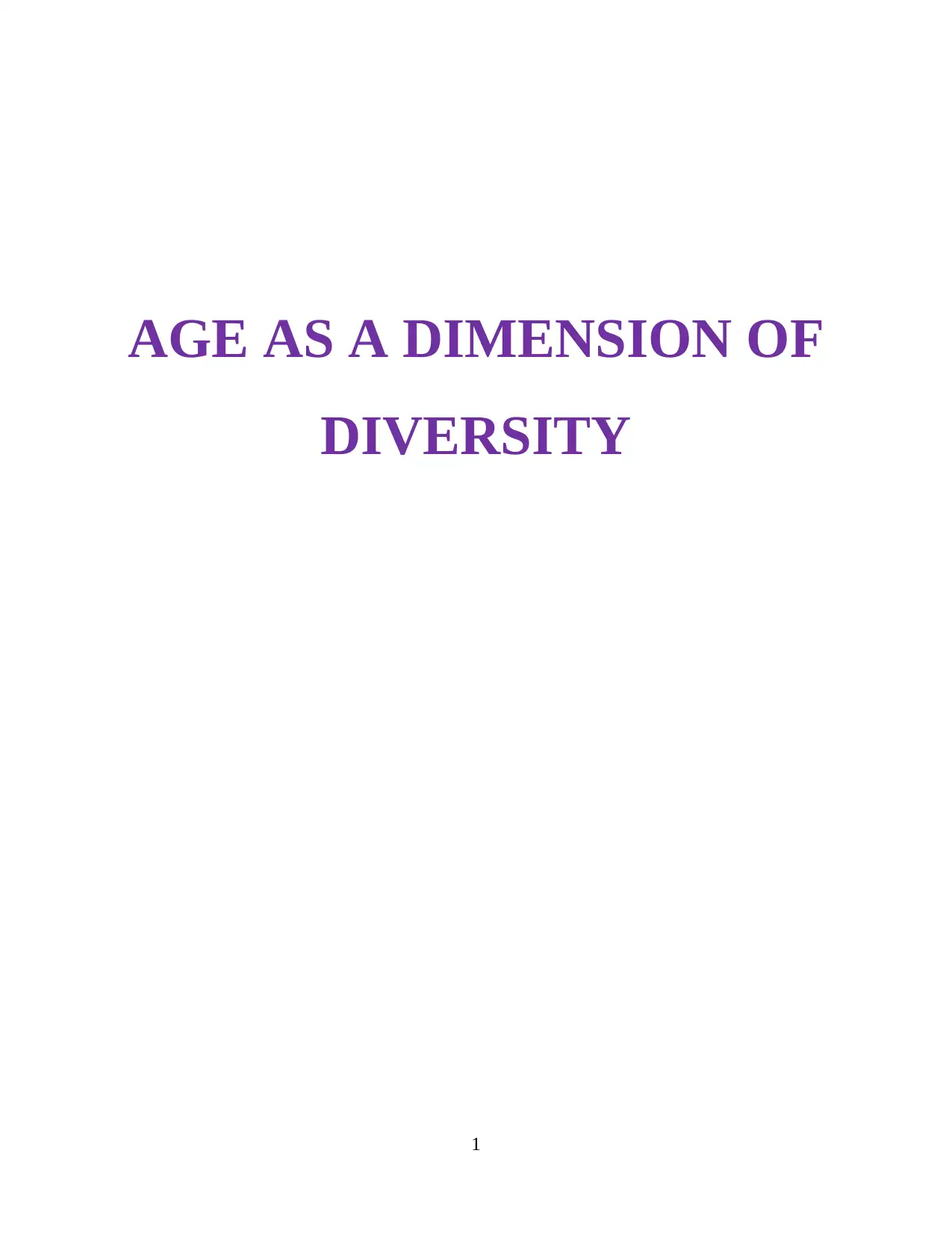
AGE AS A DIMENSION OF
DIVERSITY
1
DIVERSITY
1
Paraphrase This Document
Need a fresh take? Get an instant paraphrase of this document with our AI Paraphraser
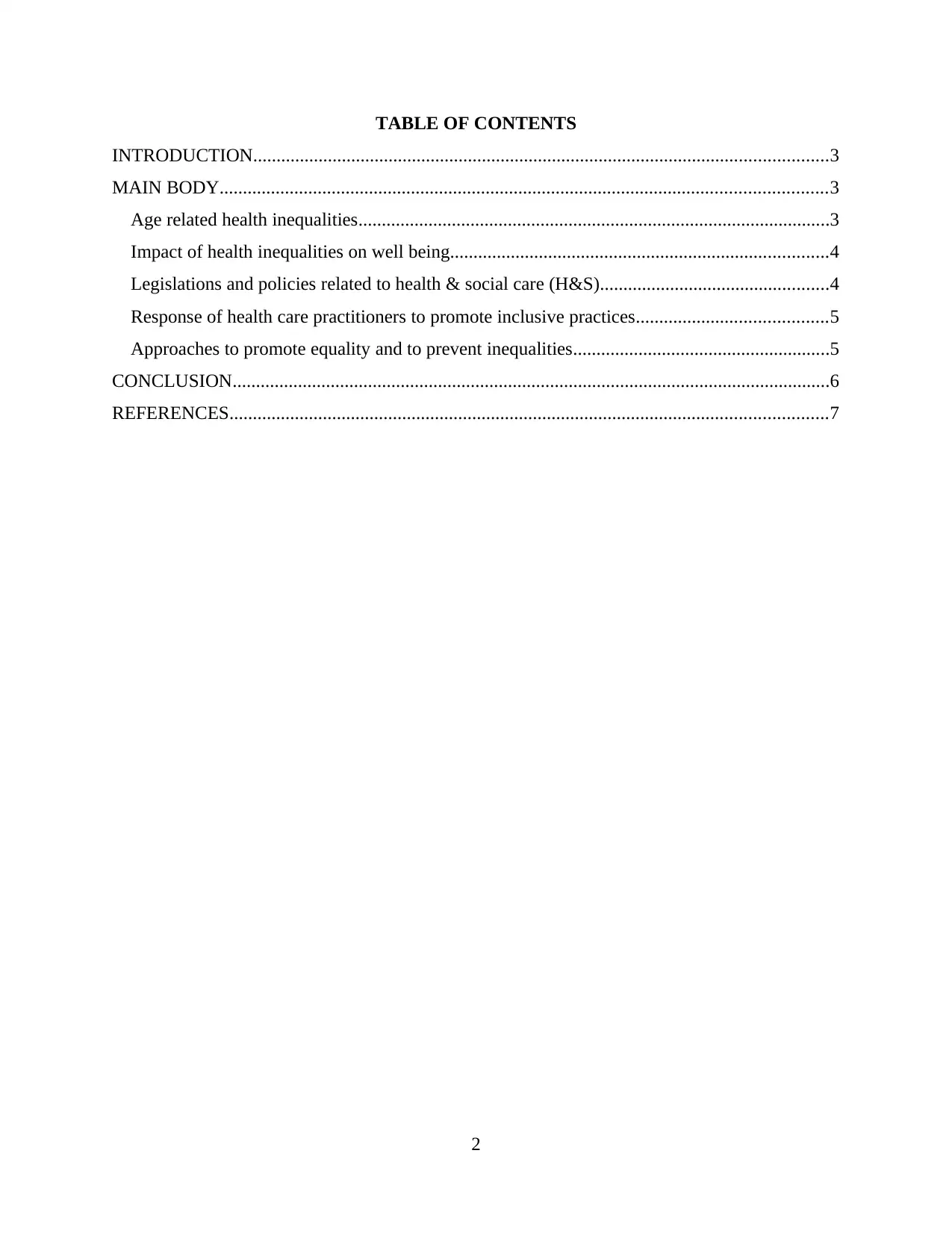
TABLE OF CONTENTS
INTRODUCTION...........................................................................................................................3
MAIN BODY..................................................................................................................................3
Age related health inequalities.....................................................................................................3
Impact of health inequalities on well being.................................................................................4
Legislations and policies related to health & social care (H&S).................................................4
Response of health care practitioners to promote inclusive practices.........................................5
Approaches to promote equality and to prevent inequalities.......................................................5
CONCLUSION................................................................................................................................6
REFERENCES................................................................................................................................7
2
INTRODUCTION...........................................................................................................................3
MAIN BODY..................................................................................................................................3
Age related health inequalities.....................................................................................................3
Impact of health inequalities on well being.................................................................................4
Legislations and policies related to health & social care (H&S).................................................4
Response of health care practitioners to promote inclusive practices.........................................5
Approaches to promote equality and to prevent inequalities.......................................................5
CONCLUSION................................................................................................................................6
REFERENCES................................................................................................................................7
2
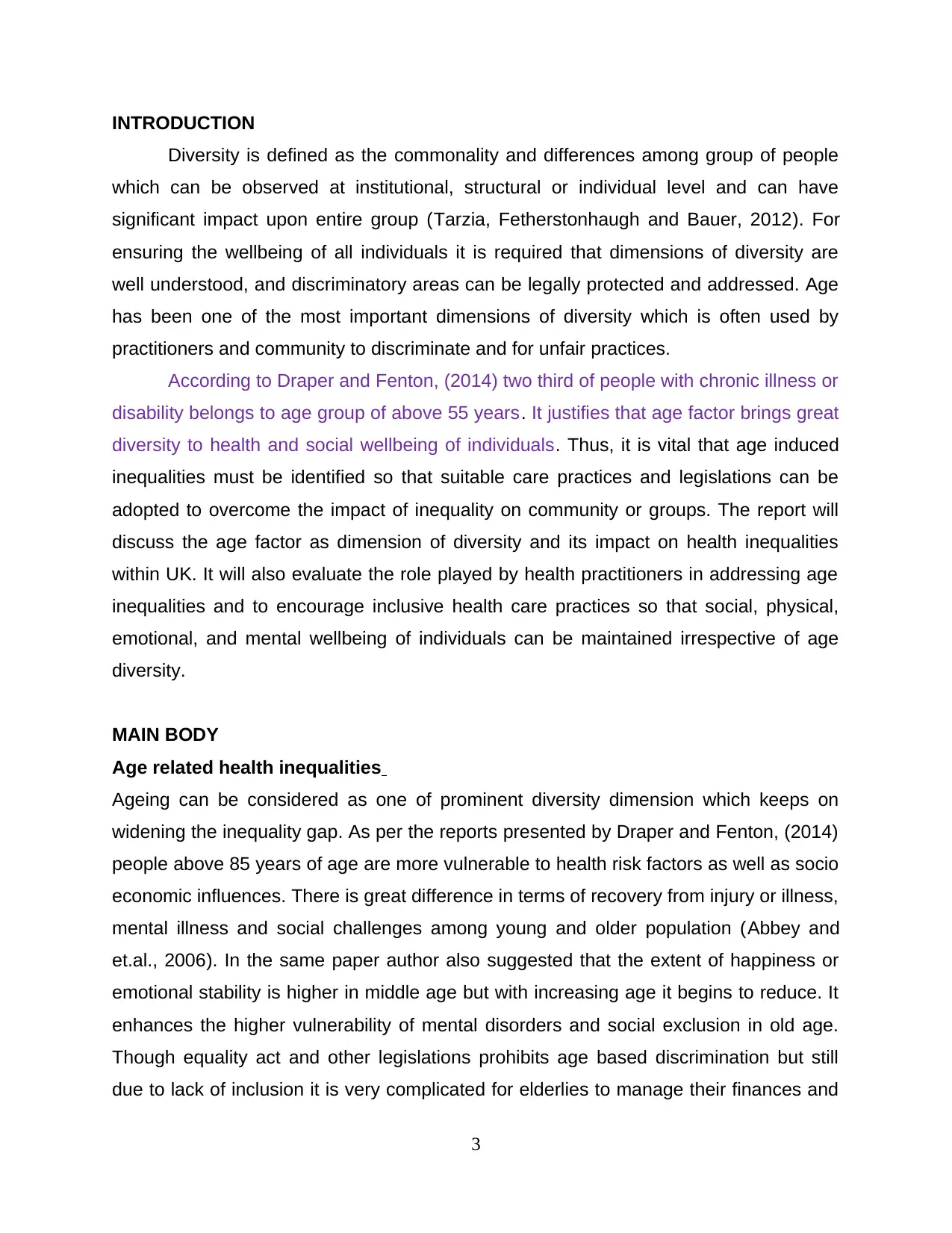
INTRODUCTION
Diversity is defined as the commonality and differences among group of people
which can be observed at institutional, structural or individual level and can have
significant impact upon entire group (Tarzia, Fetherstonhaugh and Bauer, 2012). For
ensuring the wellbeing of all individuals it is required that dimensions of diversity are
well understood, and discriminatory areas can be legally protected and addressed. Age
has been one of the most important dimensions of diversity which is often used by
practitioners and community to discriminate and for unfair practices.
According to Draper and Fenton, (2014) two third of people with chronic illness or
disability belongs to age group of above 55 years. It justifies that age factor brings great
diversity to health and social wellbeing of individuals. Thus, it is vital that age induced
inequalities must be identified so that suitable care practices and legislations can be
adopted to overcome the impact of inequality on community or groups. The report will
discuss the age factor as dimension of diversity and its impact on health inequalities
within UK. It will also evaluate the role played by health practitioners in addressing age
inequalities and to encourage inclusive health care practices so that social, physical,
emotional, and mental wellbeing of individuals can be maintained irrespective of age
diversity.
MAIN BODY
Age related health inequalities
Ageing can be considered as one of prominent diversity dimension which keeps on
widening the inequality gap. As per the reports presented by Draper and Fenton, (2014)
people above 85 years of age are more vulnerable to health risk factors as well as socio
economic influences. There is great difference in terms of recovery from injury or illness,
mental illness and social challenges among young and older population (Abbey and
et.al., 2006). In the same paper author also suggested that the extent of happiness or
emotional stability is higher in middle age but with increasing age it begins to reduce. It
enhances the higher vulnerability of mental disorders and social exclusion in old age.
Though equality act and other legislations prohibits age based discrimination but still
due to lack of inclusion it is very complicated for elderlies to manage their finances and
3
Diversity is defined as the commonality and differences among group of people
which can be observed at institutional, structural or individual level and can have
significant impact upon entire group (Tarzia, Fetherstonhaugh and Bauer, 2012). For
ensuring the wellbeing of all individuals it is required that dimensions of diversity are
well understood, and discriminatory areas can be legally protected and addressed. Age
has been one of the most important dimensions of diversity which is often used by
practitioners and community to discriminate and for unfair practices.
According to Draper and Fenton, (2014) two third of people with chronic illness or
disability belongs to age group of above 55 years. It justifies that age factor brings great
diversity to health and social wellbeing of individuals. Thus, it is vital that age induced
inequalities must be identified so that suitable care practices and legislations can be
adopted to overcome the impact of inequality on community or groups. The report will
discuss the age factor as dimension of diversity and its impact on health inequalities
within UK. It will also evaluate the role played by health practitioners in addressing age
inequalities and to encourage inclusive health care practices so that social, physical,
emotional, and mental wellbeing of individuals can be maintained irrespective of age
diversity.
MAIN BODY
Age related health inequalities
Ageing can be considered as one of prominent diversity dimension which keeps on
widening the inequality gap. As per the reports presented by Draper and Fenton, (2014)
people above 85 years of age are more vulnerable to health risk factors as well as socio
economic influences. There is great difference in terms of recovery from injury or illness,
mental illness and social challenges among young and older population (Abbey and
et.al., 2006). In the same paper author also suggested that the extent of happiness or
emotional stability is higher in middle age but with increasing age it begins to reduce. It
enhances the higher vulnerability of mental disorders and social exclusion in old age.
Though equality act and other legislations prohibits age based discrimination but still
due to lack of inclusion it is very complicated for elderlies to manage their finances and
3
⊘ This is a preview!⊘
Do you want full access?
Subscribe today to unlock all pages.

Trusted by 1+ million students worldwide
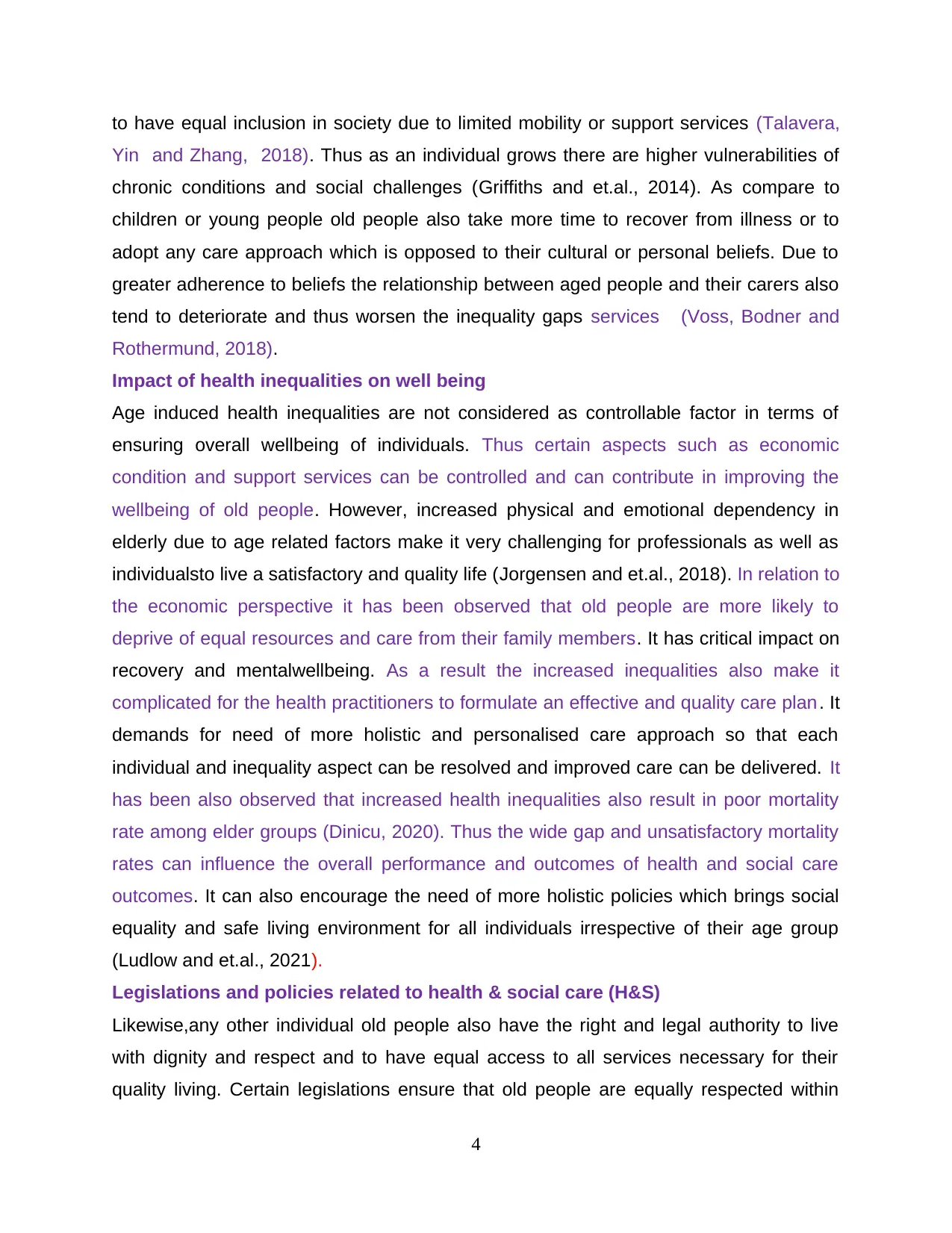
to have equal inclusion in society due to limited mobility or support services (Talavera,
Yin and Zhang, 2018). Thus as an individual grows there are higher vulnerabilities of
chronic conditions and social challenges (Griffiths and et.al., 2014). As compare to
children or young people old people also take more time to recover from illness or to
adopt any care approach which is opposed to their cultural or personal beliefs. Due to
greater adherence to beliefs the relationship between aged people and their carers also
tend to deteriorate and thus worsen the inequality gaps services (Voss, Bodner and
Rothermund, 2018).
Impact of health inequalities on well being
Age induced health inequalities are not considered as controllable factor in terms of
ensuring overall wellbeing of individuals. Thus certain aspects such as economic
condition and support services can be controlled and can contribute in improving the
wellbeing of old people. However, increased physical and emotional dependency in
elderly due to age related factors make it very challenging for professionals as well as
individualsto live a satisfactory and quality life (Jorgensen and et.al., 2018). In relation to
the economic perspective it has been observed that old people are more likely to
deprive of equal resources and care from their family members. It has critical impact on
recovery and mentalwellbeing. As a result the increased inequalities also make it
complicated for the health practitioners to formulate an effective and quality care plan . It
demands for need of more holistic and personalised care approach so that each
individual and inequality aspect can be resolved and improved care can be delivered. It
has been also observed that increased health inequalities also result in poor mortality
rate among elder groups (Dinicu, 2020). Thus the wide gap and unsatisfactory mortality
rates can influence the overall performance and outcomes of health and social care
outcomes. It can also encourage the need of more holistic policies which brings social
equality and safe living environment for all individuals irrespective of their age group
(Ludlow and et.al., 2021).
Legislations and policies related to health & social care (H&S)
Likewise,any other individual old people also have the right and legal authority to live
with dignity and respect and to have equal access to all services necessary for their
quality living. Certain legislations ensure that old people are equally respected within
4
Yin and Zhang, 2018). Thus as an individual grows there are higher vulnerabilities of
chronic conditions and social challenges (Griffiths and et.al., 2014). As compare to
children or young people old people also take more time to recover from illness or to
adopt any care approach which is opposed to their cultural or personal beliefs. Due to
greater adherence to beliefs the relationship between aged people and their carers also
tend to deteriorate and thus worsen the inequality gaps services (Voss, Bodner and
Rothermund, 2018).
Impact of health inequalities on well being
Age induced health inequalities are not considered as controllable factor in terms of
ensuring overall wellbeing of individuals. Thus certain aspects such as economic
condition and support services can be controlled and can contribute in improving the
wellbeing of old people. However, increased physical and emotional dependency in
elderly due to age related factors make it very challenging for professionals as well as
individualsto live a satisfactory and quality life (Jorgensen and et.al., 2018). In relation to
the economic perspective it has been observed that old people are more likely to
deprive of equal resources and care from their family members. It has critical impact on
recovery and mentalwellbeing. As a result the increased inequalities also make it
complicated for the health practitioners to formulate an effective and quality care plan . It
demands for need of more holistic and personalised care approach so that each
individual and inequality aspect can be resolved and improved care can be delivered. It
has been also observed that increased health inequalities also result in poor mortality
rate among elder groups (Dinicu, 2020). Thus the wide gap and unsatisfactory mortality
rates can influence the overall performance and outcomes of health and social care
outcomes. It can also encourage the need of more holistic policies which brings social
equality and safe living environment for all individuals irrespective of their age group
(Ludlow and et.al., 2021).
Legislations and policies related to health & social care (H&S)
Likewise,any other individual old people also have the right and legal authority to live
with dignity and respect and to have equal access to all services necessary for their
quality living. Certain legislations ensure that old people are equally respected within
4
Paraphrase This Document
Need a fresh take? Get an instant paraphrase of this document with our AI Paraphraser
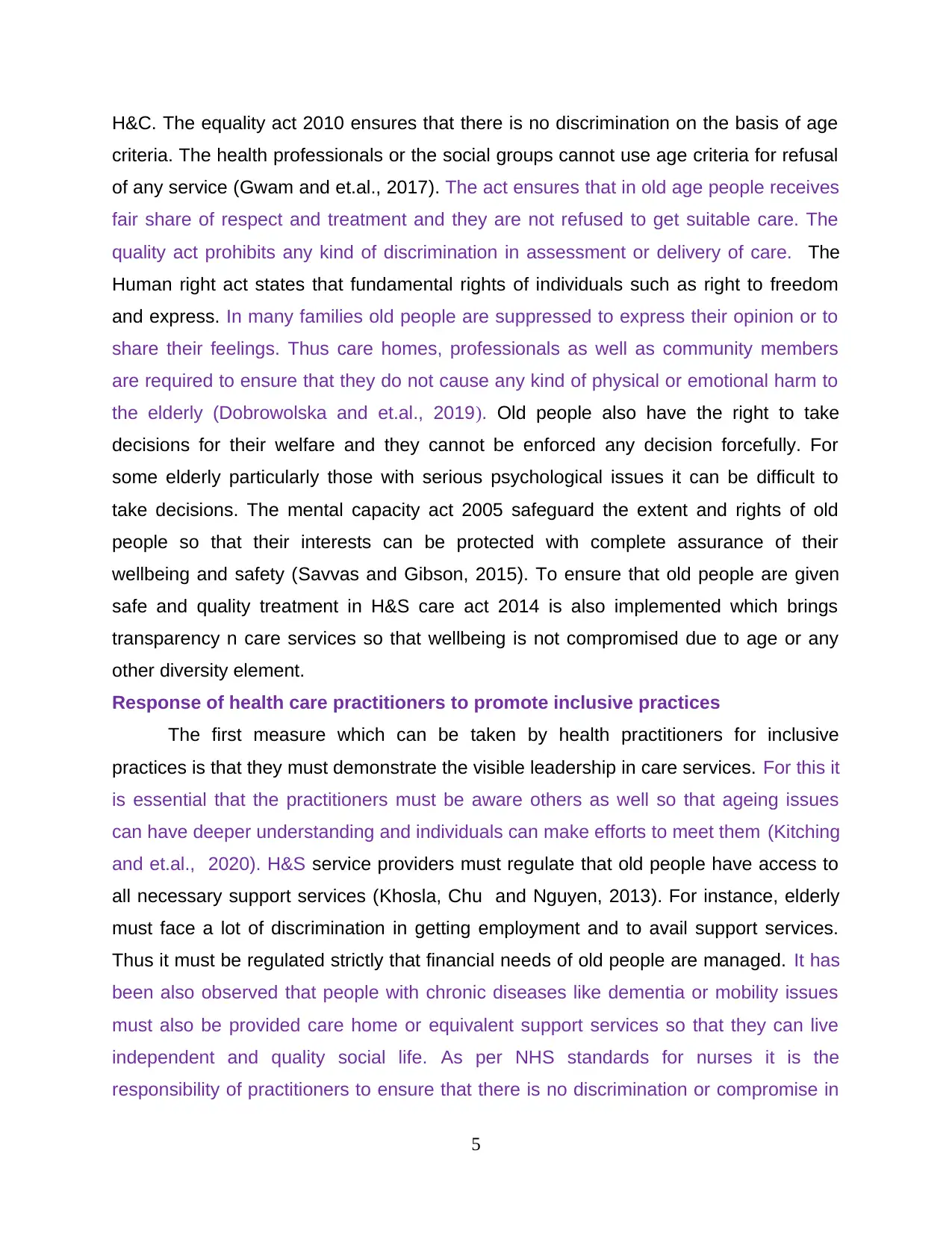
H&C. The equality act 2010 ensures that there is no discrimination on the basis of age
criteria. The health professionals or the social groups cannot use age criteria for refusal
of any service (Gwam and et.al., 2017). The act ensures that in old age people receives
fair share of respect and treatment and they are not refused to get suitable care. The
quality act prohibits any kind of discrimination in assessment or delivery of care. The
Human right act states that fundamental rights of individuals such as right to freedom
and express. In many families old people are suppressed to express their opinion or to
share their feelings. Thus care homes, professionals as well as community members
are required to ensure that they do not cause any kind of physical or emotional harm to
the elderly (Dobrowolska and et.al., 2019). Old people also have the right to take
decisions for their welfare and they cannot be enforced any decision forcefully. For
some elderly particularly those with serious psychological issues it can be difficult to
take decisions. The mental capacity act 2005 safeguard the extent and rights of old
people so that their interests can be protected with complete assurance of their
wellbeing and safety (Savvas and Gibson, 2015). To ensure that old people are given
safe and quality treatment in H&S care act 2014 is also implemented which brings
transparency n care services so that wellbeing is not compromised due to age or any
other diversity element.
Response of health care practitioners to promote inclusive practices
The first measure which can be taken by health practitioners for inclusive
practices is that they must demonstrate the visible leadership in care services. For this it
is essential that the practitioners must be aware others as well so that ageing issues
can have deeper understanding and individuals can make efforts to meet them (Kitching
and et.al., 2020). H&S service providers must regulate that old people have access to
all necessary support services (Khosla, Chu and Nguyen, 2013). For instance, elderly
must face a lot of discrimination in getting employment and to avail support services.
Thus it must be regulated strictly that financial needs of old people are managed. It has
been also observed that people with chronic diseases like dementia or mobility issues
must also be provided care home or equivalent support services so that they can live
independent and quality social life. As per NHS standards for nurses it is the
responsibility of practitioners to ensure that there is no discrimination or compromise in
5
criteria. The health professionals or the social groups cannot use age criteria for refusal
of any service (Gwam and et.al., 2017). The act ensures that in old age people receives
fair share of respect and treatment and they are not refused to get suitable care. The
quality act prohibits any kind of discrimination in assessment or delivery of care. The
Human right act states that fundamental rights of individuals such as right to freedom
and express. In many families old people are suppressed to express their opinion or to
share their feelings. Thus care homes, professionals as well as community members
are required to ensure that they do not cause any kind of physical or emotional harm to
the elderly (Dobrowolska and et.al., 2019). Old people also have the right to take
decisions for their welfare and they cannot be enforced any decision forcefully. For
some elderly particularly those with serious psychological issues it can be difficult to
take decisions. The mental capacity act 2005 safeguard the extent and rights of old
people so that their interests can be protected with complete assurance of their
wellbeing and safety (Savvas and Gibson, 2015). To ensure that old people are given
safe and quality treatment in H&S care act 2014 is also implemented which brings
transparency n care services so that wellbeing is not compromised due to age or any
other diversity element.
Response of health care practitioners to promote inclusive practices
The first measure which can be taken by health practitioners for inclusive
practices is that they must demonstrate the visible leadership in care services. For this it
is essential that the practitioners must be aware others as well so that ageing issues
can have deeper understanding and individuals can make efforts to meet them (Kitching
and et.al., 2020). H&S service providers must regulate that old people have access to
all necessary support services (Khosla, Chu and Nguyen, 2013). For instance, elderly
must face a lot of discrimination in getting employment and to avail support services.
Thus it must be regulated strictly that financial needs of old people are managed. It has
been also observed that people with chronic diseases like dementia or mobility issues
must also be provided care home or equivalent support services so that they can live
independent and quality social life. As per NHS standards for nurses it is the
responsibility of practitioners to ensure that there is no discrimination or compromise in
5
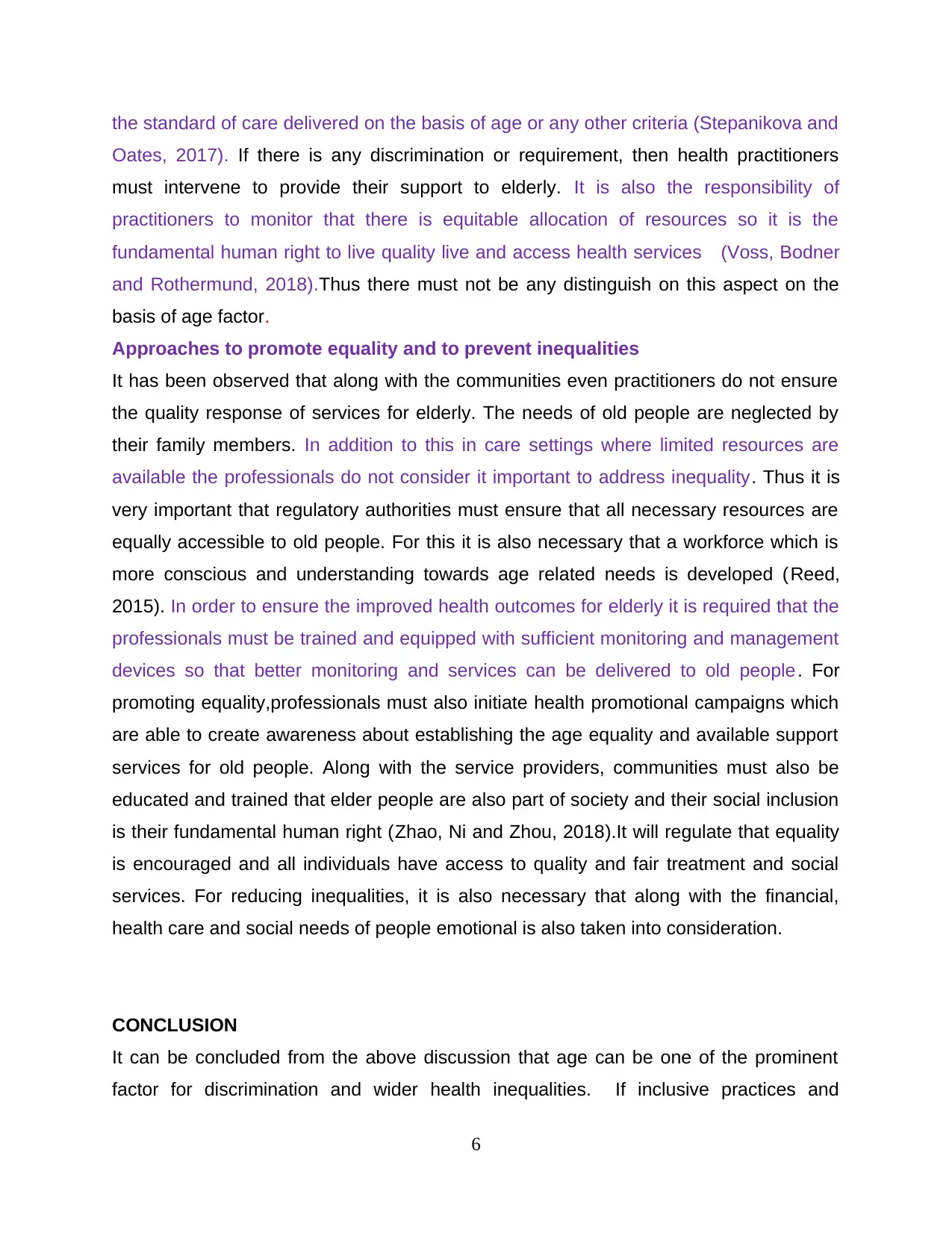
the standard of care delivered on the basis of age or any other criteria (Stepanikova and
Oates, 2017). If there is any discrimination or requirement, then health practitioners
must intervene to provide their support to elderly. It is also the responsibility of
practitioners to monitor that there is equitable allocation of resources so it is the
fundamental human right to live quality live and access health services (Voss, Bodner
and Rothermund, 2018).Thus there must not be any distinguish on this aspect on the
basis of age factor.
Approaches to promote equality and to prevent inequalities
It has been observed that along with the communities even practitioners do not ensure
the quality response of services for elderly. The needs of old people are neglected by
their family members. In addition to this in care settings where limited resources are
available the professionals do not consider it important to address inequality. Thus it is
very important that regulatory authorities must ensure that all necessary resources are
equally accessible to old people. For this it is also necessary that a workforce which is
more conscious and understanding towards age related needs is developed (Reed,
2015). In order to ensure the improved health outcomes for elderly it is required that the
professionals must be trained and equipped with sufficient monitoring and management
devices so that better monitoring and services can be delivered to old people. For
promoting equality,professionals must also initiate health promotional campaigns which
are able to create awareness about establishing the age equality and available support
services for old people. Along with the service providers, communities must also be
educated and trained that elder people are also part of society and their social inclusion
is their fundamental human right (Zhao, Ni and Zhou, 2018).It will regulate that equality
is encouraged and all individuals have access to quality and fair treatment and social
services. For reducing inequalities, it is also necessary that along with the financial,
health care and social needs of people emotional is also taken into consideration.
CONCLUSION
It can be concluded from the above discussion that age can be one of the prominent
factor for discrimination and wider health inequalities. If inclusive practices and
6
Oates, 2017). If there is any discrimination or requirement, then health practitioners
must intervene to provide their support to elderly. It is also the responsibility of
practitioners to monitor that there is equitable allocation of resources so it is the
fundamental human right to live quality live and access health services (Voss, Bodner
and Rothermund, 2018).Thus there must not be any distinguish on this aspect on the
basis of age factor.
Approaches to promote equality and to prevent inequalities
It has been observed that along with the communities even practitioners do not ensure
the quality response of services for elderly. The needs of old people are neglected by
their family members. In addition to this in care settings where limited resources are
available the professionals do not consider it important to address inequality. Thus it is
very important that regulatory authorities must ensure that all necessary resources are
equally accessible to old people. For this it is also necessary that a workforce which is
more conscious and understanding towards age related needs is developed (Reed,
2015). In order to ensure the improved health outcomes for elderly it is required that the
professionals must be trained and equipped with sufficient monitoring and management
devices so that better monitoring and services can be delivered to old people. For
promoting equality,professionals must also initiate health promotional campaigns which
are able to create awareness about establishing the age equality and available support
services for old people. Along with the service providers, communities must also be
educated and trained that elder people are also part of society and their social inclusion
is their fundamental human right (Zhao, Ni and Zhou, 2018).It will regulate that equality
is encouraged and all individuals have access to quality and fair treatment and social
services. For reducing inequalities, it is also necessary that along with the financial,
health care and social needs of people emotional is also taken into consideration.
CONCLUSION
It can be concluded from the above discussion that age can be one of the prominent
factor for discrimination and wider health inequalities. If inclusive practices and
6
⊘ This is a preview!⊘
Do you want full access?
Subscribe today to unlock all pages.

Trusted by 1+ million students worldwide
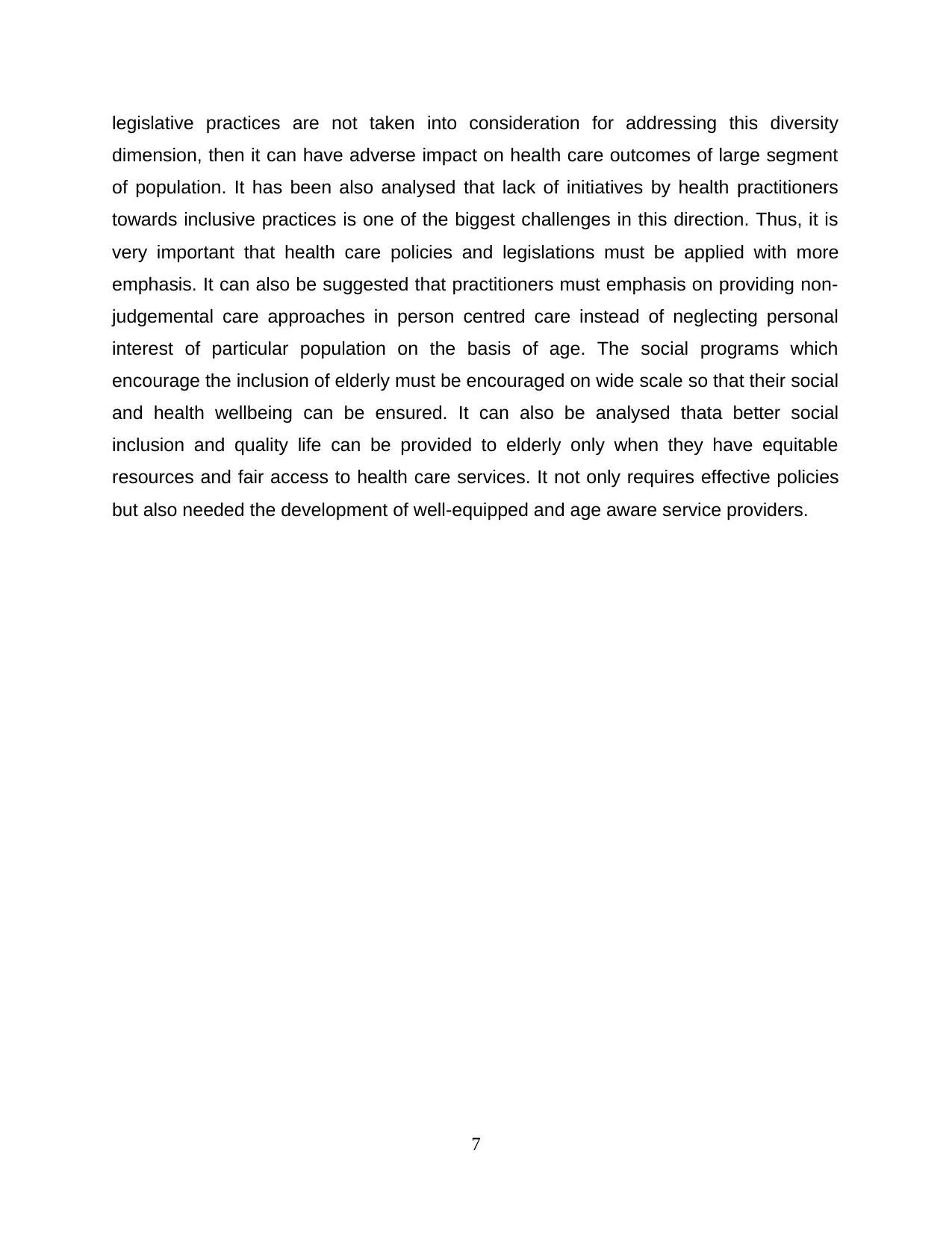
legislative practices are not taken into consideration for addressing this diversity
dimension, then it can have adverse impact on health care outcomes of large segment
of population. It has been also analysed that lack of initiatives by health practitioners
towards inclusive practices is one of the biggest challenges in this direction. Thus, it is
very important that health care policies and legislations must be applied with more
emphasis. It can also be suggested that practitioners must emphasis on providing non-
judgemental care approaches in person centred care instead of neglecting personal
interest of particular population on the basis of age. The social programs which
encourage the inclusion of elderly must be encouraged on wide scale so that their social
and health wellbeing can be ensured. It can also be analysed thata better social
inclusion and quality life can be provided to elderly only when they have equitable
resources and fair access to health care services. It not only requires effective policies
but also needed the development of well-equipped and age aware service providers.
7
dimension, then it can have adverse impact on health care outcomes of large segment
of population. It has been also analysed that lack of initiatives by health practitioners
towards inclusive practices is one of the biggest challenges in this direction. Thus, it is
very important that health care policies and legislations must be applied with more
emphasis. It can also be suggested that practitioners must emphasis on providing non-
judgemental care approaches in person centred care instead of neglecting personal
interest of particular population on the basis of age. The social programs which
encourage the inclusion of elderly must be encouraged on wide scale so that their social
and health wellbeing can be ensured. It can also be analysed thata better social
inclusion and quality life can be provided to elderly only when they have equitable
resources and fair access to health care services. It not only requires effective policies
but also needed the development of well-equipped and age aware service providers.
7
Paraphrase This Document
Need a fresh take? Get an instant paraphrase of this document with our AI Paraphraser
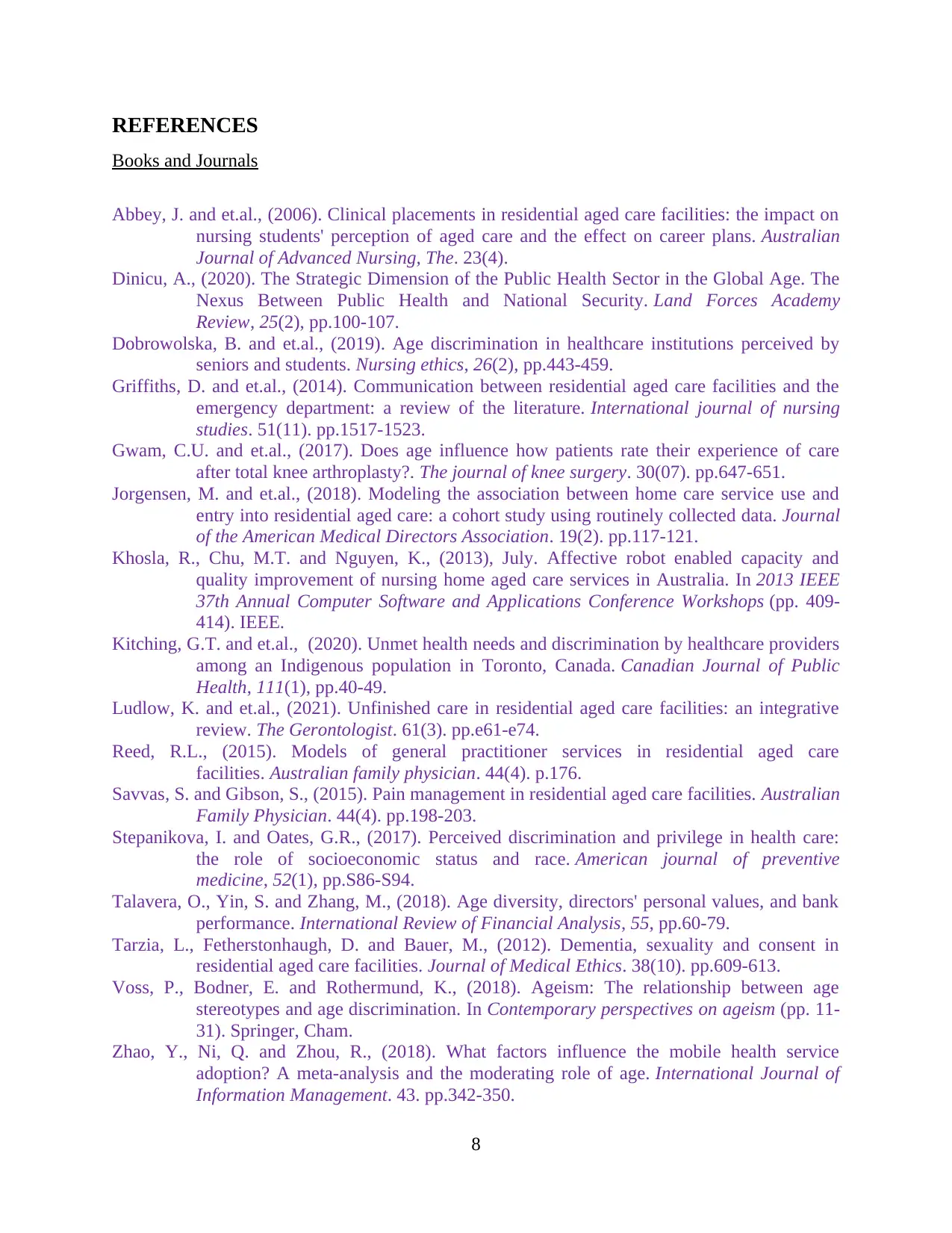
REFERENCES
Books and Journals
Abbey, J. and et.al., (2006). Clinical placements in residential aged care facilities: the impact on
nursing students' perception of aged care and the effect on career plans. Australian
Journal of Advanced Nursing, The. 23(4).
Dinicu, A., (2020). The Strategic Dimension of the Public Health Sector in the Global Age. The
Nexus Between Public Health and National Security. Land Forces Academy
Review, 25(2), pp.100-107.
Dobrowolska, B. and et.al., (2019). Age discrimination in healthcare institutions perceived by
seniors and students. Nursing ethics, 26(2), pp.443-459.
Griffiths, D. and et.al., (2014). Communication between residential aged care facilities and the
emergency department: a review of the literature. International journal of nursing
studies. 51(11). pp.1517-1523.
Gwam, C.U. and et.al., (2017). Does age influence how patients rate their experience of care
after total knee arthroplasty?. The journal of knee surgery. 30(07). pp.647-651.
Jorgensen, M. and et.al., (2018). Modeling the association between home care service use and
entry into residential aged care: a cohort study using routinely collected data. Journal
of the American Medical Directors Association. 19(2). pp.117-121.
Khosla, R., Chu, M.T. and Nguyen, K., (2013), July. Affective robot enabled capacity and
quality improvement of nursing home aged care services in Australia. In 2013 IEEE
37th Annual Computer Software and Applications Conference Workshops (pp. 409-
414). IEEE.
Kitching, G.T. and et.al., (2020). Unmet health needs and discrimination by healthcare providers
among an Indigenous population in Toronto, Canada. Canadian Journal of Public
Health, 111(1), pp.40-49.
Ludlow, K. and et.al., (2021). Unfinished care in residential aged care facilities: an integrative
review. The Gerontologist. 61(3). pp.e61-e74.
Reed, R.L., (2015). Models of general practitioner services in residential aged care
facilities. Australian family physician. 44(4). p.176.
Savvas, S. and Gibson, S., (2015). Pain management in residential aged care facilities. Australian
Family Physician. 44(4). pp.198-203.
Stepanikova, I. and Oates, G.R., (2017). Perceived discrimination and privilege in health care:
the role of socioeconomic status and race. American journal of preventive
medicine, 52(1), pp.S86-S94.
Talavera, O., Yin, S. and Zhang, M., (2018). Age diversity, directors' personal values, and bank
performance. International Review of Financial Analysis, 55, pp.60-79.
Tarzia, L., Fetherstonhaugh, D. and Bauer, M., (2012). Dementia, sexuality and consent in
residential aged care facilities. Journal of Medical Ethics. 38(10). pp.609-613.
Voss, P., Bodner, E. and Rothermund, K., (2018). Ageism: The relationship between age
stereotypes and age discrimination. In Contemporary perspectives on ageism (pp. 11-
31). Springer, Cham.
Zhao, Y., Ni, Q. and Zhou, R., (2018). What factors influence the mobile health service
adoption? A meta-analysis and the moderating role of age. International Journal of
Information Management. 43. pp.342-350.
8
Books and Journals
Abbey, J. and et.al., (2006). Clinical placements in residential aged care facilities: the impact on
nursing students' perception of aged care and the effect on career plans. Australian
Journal of Advanced Nursing, The. 23(4).
Dinicu, A., (2020). The Strategic Dimension of the Public Health Sector in the Global Age. The
Nexus Between Public Health and National Security. Land Forces Academy
Review, 25(2), pp.100-107.
Dobrowolska, B. and et.al., (2019). Age discrimination in healthcare institutions perceived by
seniors and students. Nursing ethics, 26(2), pp.443-459.
Griffiths, D. and et.al., (2014). Communication between residential aged care facilities and the
emergency department: a review of the literature. International journal of nursing
studies. 51(11). pp.1517-1523.
Gwam, C.U. and et.al., (2017). Does age influence how patients rate their experience of care
after total knee arthroplasty?. The journal of knee surgery. 30(07). pp.647-651.
Jorgensen, M. and et.al., (2018). Modeling the association between home care service use and
entry into residential aged care: a cohort study using routinely collected data. Journal
of the American Medical Directors Association. 19(2). pp.117-121.
Khosla, R., Chu, M.T. and Nguyen, K., (2013), July. Affective robot enabled capacity and
quality improvement of nursing home aged care services in Australia. In 2013 IEEE
37th Annual Computer Software and Applications Conference Workshops (pp. 409-
414). IEEE.
Kitching, G.T. and et.al., (2020). Unmet health needs and discrimination by healthcare providers
among an Indigenous population in Toronto, Canada. Canadian Journal of Public
Health, 111(1), pp.40-49.
Ludlow, K. and et.al., (2021). Unfinished care in residential aged care facilities: an integrative
review. The Gerontologist. 61(3). pp.e61-e74.
Reed, R.L., (2015). Models of general practitioner services in residential aged care
facilities. Australian family physician. 44(4). p.176.
Savvas, S. and Gibson, S., (2015). Pain management in residential aged care facilities. Australian
Family Physician. 44(4). pp.198-203.
Stepanikova, I. and Oates, G.R., (2017). Perceived discrimination and privilege in health care:
the role of socioeconomic status and race. American journal of preventive
medicine, 52(1), pp.S86-S94.
Talavera, O., Yin, S. and Zhang, M., (2018). Age diversity, directors' personal values, and bank
performance. International Review of Financial Analysis, 55, pp.60-79.
Tarzia, L., Fetherstonhaugh, D. and Bauer, M., (2012). Dementia, sexuality and consent in
residential aged care facilities. Journal of Medical Ethics. 38(10). pp.609-613.
Voss, P., Bodner, E. and Rothermund, K., (2018). Ageism: The relationship between age
stereotypes and age discrimination. In Contemporary perspectives on ageism (pp. 11-
31). Springer, Cham.
Zhao, Y., Ni, Q. and Zhou, R., (2018). What factors influence the mobile health service
adoption? A meta-analysis and the moderating role of age. International Journal of
Information Management. 43. pp.342-350.
8
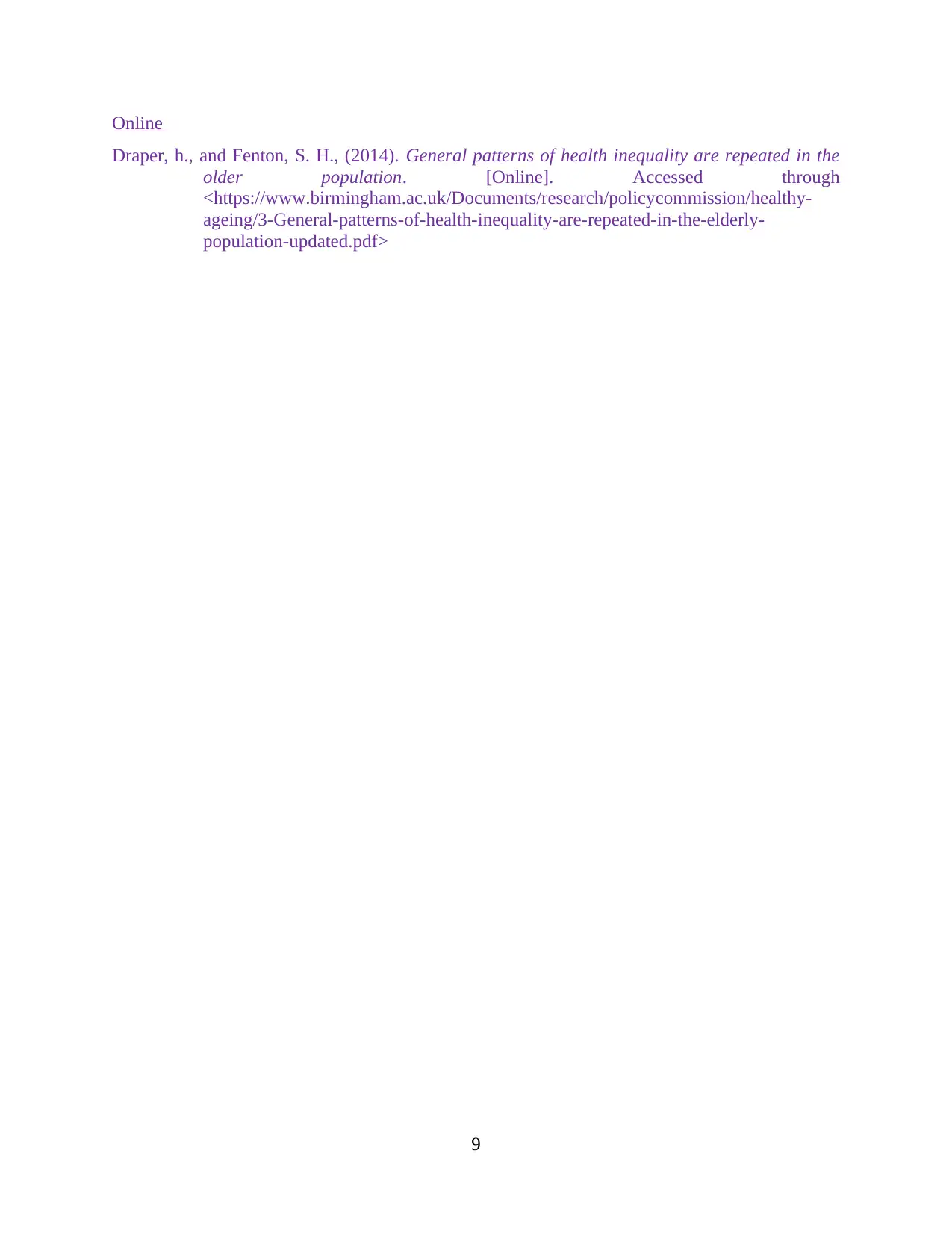
Online
Draper, h., and Fenton, S. H., (2014). General patterns of health inequality are repeated in the
older population. [Online]. Accessed through
<https://www.birmingham.ac.uk/Documents/research/policycommission/healthy-
ageing/3-General-patterns-of-health-inequality-are-repeated-in-the-elderly-
population-updated.pdf>
9
Draper, h., and Fenton, S. H., (2014). General patterns of health inequality are repeated in the
older population. [Online]. Accessed through
<https://www.birmingham.ac.uk/Documents/research/policycommission/healthy-
ageing/3-General-patterns-of-health-inequality-are-repeated-in-the-elderly-
population-updated.pdf>
9
⊘ This is a preview!⊘
Do you want full access?
Subscribe today to unlock all pages.

Trusted by 1+ million students worldwide
1 out of 9
Related Documents
Your All-in-One AI-Powered Toolkit for Academic Success.
+13062052269
info@desklib.com
Available 24*7 on WhatsApp / Email
![[object Object]](/_next/static/media/star-bottom.7253800d.svg)
Unlock your academic potential
Copyright © 2020–2025 A2Z Services. All Rights Reserved. Developed and managed by ZUCOL.




